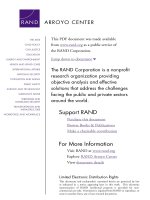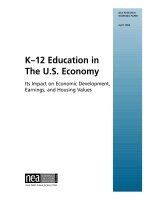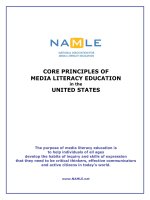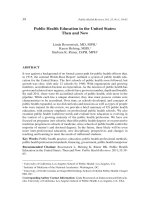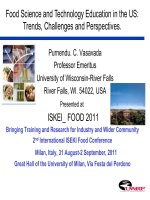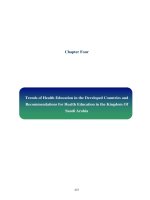Food Science and Technology Education in the US: Trends, Challenges and Perspectives. ppt
Bạn đang xem bản rút gọn của tài liệu. Xem và tải ngay bản đầy đủ của tài liệu tại đây (1.37 MB, 33 trang )
Purnendu. C. Vasavada
Professor Emeritus
University of Wisconsin-River Falls
River Falls, WI. 54022, USA
Presented at
ISKEI_ FOOD 2011
Bringing Training and Research for Industry and Wider Community
2
nd
International ISEKI Food Conference
Milan, Italy, 31 August-2 September, 2011
Great Hall of the University of Milan, Via Festa del Perdono
Food Science and Technology Education in the US:
Trends, Challenges and Perspectives.
Overview
!! Introduction
!! Food Science &Technology Education in the US
!! IFT “recognized” Programs
!! Trends influencing Food Science Education
!!Changing paradigm
– knowledge dissemination - Active learning
!! Challenges
!! Perspective
!! Summary
Food Science and Technology as
Academic Discipline
!! 1950-1960s Food Science and Technology
programs originated from commodity- based
disciplines
!! Recognition of unifying principles in food
preservation and processing, and need for
approaching problems and developments in the
fast growing food industry on scientific basis
!! Most universities developed food science
departments by merging/changing commodity
based departments. i.e. Dairy Science, Meat
Science, Cereal science.
Food Science and Technology as
Academic Discipline
!! Under stress and struggling for recognition,
visibility and relevance.
!! Encouraging Trends in placement
!! Enrolment very encouraging for some, not so for
others.
IFT and Food Science &
Technology Education
!! Minimum standards for undergraduate curriculum
established in 1966
!! Revised in1977, 1992, 2010
!! Established core curriculum, organization and budget,
minimum faculty, facilities, required courses and other
recommended courses and skills
!! Core competencies required of all undergraduate food
Science students
!! Undergraduate Curriculum Minimum Standards designed
to assure rigorous scientific training and develop
professional skills for students enrolled in IFT approved
curriculum.
!! Defined Food Science and Food Technology
!! Differentiated from Home Economics (Nutrition
and dietetics) and commodity production.
!! “Recognition” vs. formal accreditation
!!IFT “ Recognized” Programs meet or exceed
Minimum Standards for Undergraduate Education
!!Reviewed and approved by the IFT Higher
Education Review Board
!! Students from recognized programs can compete
for undergraduate scholarships
IFT and Food Science &
Technology Education
IFT “Approved” Universities/Programs
!!48 IFT approved programs
!! 40 in the US
!! 8 in Canada, Mexico,
Indonesia and China
!! Not all options meet IFT
requirements
!! A few undergraduate
programs phased out
UW RF
UW Madison
Food Science and Technology Education
at the UW River Falls
!! UW-River Falls Food Science major started in 1969.
First graduates in 1973.
!! New Pilot plants and Laboratory facilities - 1982
!! FS program peaked at > 55 students and 4.5 FTE
!! Decline in enrolment, FTE reduction due to budget
cuts, Resource competitions with other majors and
program – mid 1990s-2000s
!! FS enrolment bounced back to 45 + in 2007 but
program suspended as a result of strategic planning
and resource reallocation- 2011.
Trends Influencing Food Science and Technology
Industry
Consumer
Regulatory
!! Industry
!! Consumer
!! Regulatory
!! Globalization
!! Sourcing and supply chain management
!! M&A. and Workforce issues
!! Economics and business climate
!! Industry practices- GFSI, SQF, ISO
!! GATT-Codex
!! Government Regulations - FSMA 2011
!! Consumer demands for Nutrition, Wellness and
health, Organic, Natural, Ethnic food, Local foods,
Carbon foot print
Trends Influencing Food Science an Technology
!! Enrollment levels and sources
!! Gender and diversity
!! Recognition of Food Science as a scientific discipline
!! Changing paradigm- from instructional to learning
(knowledge dissemination to learning and skill development)
!! International study tours and semester/year abroad
!! Undergraduate Research
!! Growth of Nutrition, Dietetics and Culinary disciplines
Food Science and Technology
Education - Trends
!! Drastic and sustained budget cuts
!! State support reduced from >48-50% to < 20%
!! Emphasis on “extramural” funds generation by
faculty to support research.
!! Salary cuts, Mandatory furloughs , hiring freezes
!! Reduced, Lab support, field trips and other activities
!! Key courses taught by temporary and “adjuncts” staff
!! Increased teaching loads, Infrequent course offerings
and dropping of “lab- based” courses
!!Industry- University partnerships and major
endowment /fund raising efforts
Budget Cuts Affect Food Science Programs
Enrollment Trends
!! Food Science enrollment increased by 25% or more since
2007
!! Some universities with < 90, a few w/ others 40-75 and
others with <20 students
!! > 2600 total undergraduate enrollment
!! No. of graduated ~ 500
Students in IFT Programs – 2006-2010
2006 2008 2010 % Diff.
Undergrad 2145 2337 2774 29%
Seniors 473 515 692 47%
Grad School
Bound
133 123 176 33%
Source: Moira McGrath, 2011 .
.
Employment Trends
!! Recent History – 2008-2009
!! Worst market ever!!
!! Expansion plans and corporate
investments put on hold
!! Misconceptions about
unemployment and discouraging
job market for food scientists and
technologists
!! Layoffs
!! Lots of unemployed food scientists
!! Who else is out there!.cheap
Employment Trends
!! Recent History – 2010-2011
!!Great improvement in 2011!
!! Economic Recovery (Sluggish)
!! Less fear in the marketplace?
!! Graduates from prior years found employment
!! Hiring improving in 2010
!! Many major projects and investments started
!! More opportunity for 2011 grads
WHAT’S HOT!
!! Food Safety
!! Microbiology
!!Product Development
!!Technical service/
Marketing
!! Quality Assurance
!! Sanitation
Source: Moira McGrath,, 2011 CURRENTHIRING TRENDS FOR FOOD SCIENTISTS2011
.
WHAT’S HOT! – Food Safety
!! Why?
!! Well publicized outbreaks and recalls, food safety
issues
!! Companies need to comply with HACCP, GFSI,
Quality Assurance
!! New regulations – FSMA 2011,
!! Sanitation, Hygiene and environmental
monitoring of pathogens
!! Bioterrorism and Food Defense
Source: Moira McGrath, 2011 .
.
WHAT’S HOT! – Nutrition, Food and Health
!! Why?
!! Trans-fat free, Reduced fat, Reduced Sodium
!! Whole grains – baked goods
!! Calcium enriched
!! Antioxidants , Antimicrobials
!! Prebiotic, Probiotics
FOOD SCIENCE POSITIONS AVAILABLE
!! Product Development
!! Clinical Research
!! Nutrition Marketing
!! R & D , Product development and Sensory
!! Quality Assurance and Regulatory affairs
!! Food engineers
!! BS, MS, PhD levels
SHORTAGES OF TALENT IN INDUSTRY
!! Food Safety
!! Bakery Science
!!Dairy Science
!!Sensory Science
!!Regulatory Affairs
Best industry to be in a bad economy
Moira McGrath- Opus International 2011.
Undergraduate Research and other
innovative programs
!! Coop Internship
!! Food Industry Fellow
!! Undergraduate Research
!! Special Problems
!! High School Ambassadors
!! HACCP certification
!! Cheesemakers course
!! Pasteurization school
!! Professional Identity/recognition
!! Retention and recruitment of students
!! Students” quality” and background and academic
preparation prior to enrolling in Food Science
!! Information explosion and acquiring skills and
Knowledge
!! Social media and attention gap
!! Faculty recruitment, retention and rewards
!! Graduate students training
!! Facility upgrades and maintenance
Food Science and Technology Education -
Challenges
Employers seek more than technical knowledge
Source: Melissa Kahn, 2011.
Professional Identity/recognition
!! Food Science identity crisis
!! Academic major housed in Agriculture College
!! Not recognized as a STEM discipline
!! Not too many high school science teachers and
counselors familiar with Food Science
!! Lack of parental encouragement


